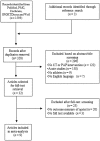Short-term adaptations following Complex Training in team-sports: A meta-analysis
- PMID: 28662108
- PMCID: PMC5491153
- DOI: 10.1371/journal.pone.0180223
Short-term adaptations following Complex Training in team-sports: A meta-analysis
Abstract
Objective: The purpose of this meta-analysis was to study the short-term adaptations on sprint and vertical jump (VJ) performance following Complex Training (CT) in team-sports. CT is a resistance training method aimed at developing both strength and power, which has a direct effect on sprint and VJ. It consists on alternating heavy resistance training exercises with plyometric/power ones, set for set, on the same workout.
Methods: A search of electronic databases up to July 2016 (PubMed-MEDLINE, SPORTDiscus, Web of Knowledge) was conducted. Inclusion criteria: 1) at least one CT intervention group; 2) training protocols ≥4-wks; 3) sample of team-sport players; 4) sprint or VJ as an outcome variable. Effect sizes (ES) of each intervention were calculated and subgroup analyses were performed.
Results: A total of 9 studies (13 CT groups) met the inclusion criteria. Medium effect sizes (ES) (ES = 0.73) were obtained for pre-post improvements in sprint, and small (ES = 0.41) in VJ, following CT. Experimental-groups presented better post-intervention sprint (ES = 1.01) and VJ (ES = 0.63) performance than control-groups.
Sprint: large ESs were exhibited in younger athletes (<20 years old; ES = 1.13); longer CT interventions (≥6 weeks; ES = 0.95); conditioning activities with intensities ≤85% 1RM (ES = 0.96) and protocols with frequencies of <3 sessions/week (ES = 0.84). Medium ESs were obtained in Division I players (ES = 0.76); training programs >12 total sessions (ES = 0.74).
Vj: Large ESs in programs with >12 total sessions (ES = 0.81). Medium ESs obtained for under-Division I individuals (ES = 0.56); protocols with intracomplex rest intervals ≥2 min (ES = 0.55); conditioning activities with intensities ≤85% 1RM (ES = 0.64); basketball/volleyball players (ES = 0.55). Small ESs were found for younger athletes (ES = 0.42); interventions ≥6 weeks (ES = 0.45).
Conclusions: CT interventions have positive medium effects on sprint performance and small effects on VJ in team-sport athletes. This training method is a suitable option to include in the season planning.
Conflict of interest statement
Figures





References
-
- Cormie P, McGuigan MR, Newton RU. Developing maximal neuromuscular power: part 2—training considerations for improving maximal power production. Sports Med. 2011;41(2):125–46. Epub 2011/01/20. doi: 10.2165/11538500-000000000-00000 . - DOI - PubMed
-
- Bolger R, Lyons M, Harrison AJ, Kenny IC. Sprinting Performance and Resistance-Based Training Interventions: A Systematic Review. J Strength Cond Res. 2015;29(4):1146–56. doi: 10.1519/JSC.0000000000000720 - DOI - PubMed
-
- García-Pinillos F, Martínez-Amat A, Hita-Contreras F, Martínez-López EJ, Latorre-Román PA. Effects of a contrast training program without external load on vertical jump, kicking speed, sprint, and agility of young soccer players. J Strength Cond Res. 2014;28(9):2452–60. doi: 10.1519/JSC.0000000000000452 - DOI - PubMed
-
- Faude O, Koch T, Meyer T. Straight sprinting is the most frequent action in goal situations in professional football. Journal of sports sciences. 2012;30(7):625–31. doi: 10.1080/02640414.2012.665940 - DOI - PubMed
-
- Duthie G, Pyne D, Hooper S. Time motion analysis of 2001 and 2002 super 12 rugby. J Sport Sci. 2005;23(5):523–30. - PubMed
Publication types
MeSH terms
LinkOut - more resources
Full Text Sources
Other Literature Sources
Miscellaneous

